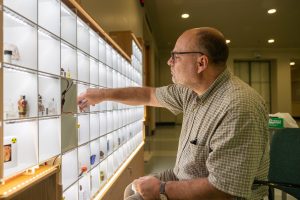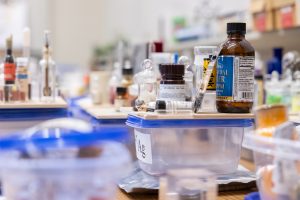Christian Brückner started collecting more than 45 years ago when he was a young teenager in Germany and his father a metallurgist who’d bring home laboratory leftovers to feed his son’s growing interest in crystals and science.
From an early 19th century bottle of a mercury salt to manganese nodules scooped from the bottom of the Pacific, Brückner’s childhood collection grew piece by piece through the decades. He came upon a tungsten carbide tool used to draw heavy wires from a thick diameter to a thinner one during a summer job as a student. Later on in academia, a retiring colleague gave him an antistatic brush once charged with polonium.
The collection amassed to more than a thousand pieces, some valued at only pennies and others much more, all taking up space in his office, laboratory, and home. Some boxes hadn’t been opened for several decades.
“That was not the right place for any collection,” he says, gesturing to what is the right place – a wall-sized periodic table in the second-floor atrium of the Chemistry Building, lit from inside with strings of LED lights that can be manipulated to highlight groups of elements like the noble gases or to talk specifically about a single element and the things contained in its cubby. Take, for instance, the antique domino in the nitrogen cubby (it’s in the plastic) or the pair of sunglasses cut in half and spanning the praseodymium and neodymium cases (both elements are in the lenses).

“This is the right place, because now one can show off each artifact, share its delights, and it tells a story in context,” he says. “I wanted the display to house more than just pieces of metal and bulbs of gas. I wanted to connect each element to the natural world, our daily lives, and the work that we do in research labs, from gold-coated contacts, a bottle of Selsun Blue, beautiful minerals, and iconic reagents to chemical compounds unique to the research of members of our department.”
But the task of bringing an interactive periodic table to UConn wasn’t a quick one and the idea wasn’t particularly unique.
Brückner says many universities, private collectors, and companies boast periodic table displays, and some have become almost tourist draws, like the one at the University of Oklahoma that Brückner visited during a sabbatical many years ago.
But when he conjured the idea of bringing an exhibit like that to UConn, he wanted it to be different. Usually, only a few examples of each element are shown in each cubby, keeping the 118 pigeonholes tidy but not really exemplifying the range of use for each element.
“I wanted to include as many examples as possible to weave a dense fabric of as many aspects of each element as possible,” Brückner says. “Chemistry is the central science, and the periodic table holds it all together.”
In 2017, not long after becoming department head and having lined up emeritus professor Ulli Mueller-Westerhoff as a major donor, Brückner had the first conversations with a European company specializing not only in making periodic table cases but also providing samples for the display.
Of course, Brückner knew he needed only a fraction of the number of samples other places might to fill the holes in his collection, like an antique bedside alarm clock with radium-painted numbers that glow or a sphere of volatile liquid bromine.
He also wanted the shape of the full exhibit to look different than others, which usually are rectangular and made so with strategically placed cabinets to fill in the space around the irregularly shaped periodic table.
Cabinetmaker Marcos Palomo of 118 Displays suggested a display in the very shape of the periodic table and Brückner was sold. A wall-mounted monitor at the top would crown it and two freestanding interactive kiosks would bookend it.
Over the next five years, as project approvals wended the pipeline, Mueller-Westerhoff passed away, his sister picked up his pledge, and UConn’s Office of the Provost and the Brückner family added additional funding.
One constant continued: Brückner kept collecting, now with a defined purpose.
“I scoured, for example, Etsy for a very long time and found interesting samples, like europium-colored glass. It wasn’t advertised as europium-colored glass, but its color was exactly what I would have expected for europium-colored glass – pink, a very unique pink. I also found buttons made out of this pink glass,” he says.
He mentioned the project to an alumnus who works at Boston Scientific and donated coronary stents and heart valve frameworks made from a nickel and titanium alloy. He unsuccessfully solicited local hospitals for an empty bottle of an imaging agent that is gadolinium-based but eventually procured a full bottle from a graduate school friend who is co-director of an imaging center at Harvard Medical School.

“There are items in there from colleagues long passed, there are items there from current colleagues, there are items from alumni,” Brückner says, noting that when he told people what he was doing they were eager to be a part of the story – his dentist offered a titanium-based dental implant.
“We have a nickel-iron meteorite from outer space in there, items fished from air, and things from the bottom of the ocean,” he says. “There is a piece of fused sand from the first nuclear explosion, the Trinity hydrogen bomb test in New Mexico. It arguably contains some of the radioactive fallout, elements not otherwise accessible or safe to handle.”
In the aluminum cube, Brückner put in a spoon that he picked up when he was visiting the East Bloc in Prague at 15 years old: “I like to tell the story in my inorganic chemistry class that the first aluminum cutlery was given to the king of France because at the time people learned how to make elemental aluminum it was more expensive than gold. If you wanted to be fancy, you had aluminum cutlery. Now, we have aluminum soda cans. Things change, and to me this aluminum cutlery is a link to that story.”
While there is a uranium glass sugar bowl – a beautiful green – in the display, not all elements could be represented because they are radioactive and only small amounts have ever been made. These cubes instead hold just a representative picture, think Albert Einstein for einsteinium or Enrico Fermi for fermium.
But other man-made elements that might be more obscure to the layman are represented: “Americium, we have that in smoke detectors. There’s a little americium source in there,” he says.
With physically larger samples of some elements on reserve out of the display – part of the transatlantic cable filled with copper wires or a small but weighty ingot of tungsten, for instance – Brückner says he has a bucket of show-and-tell items that groups could use for a quick lesson when they visit campus.
After all, he says, that’s a goal of the project.
“I would also like it to be an educational tool,” he says. “It can be a centerpiece for outreach activities to the general public. It’s like a mini museum for anyone from elementary school students to adults of any age. Anybody could find some items in the display they can relate to and see the fun in this.”


